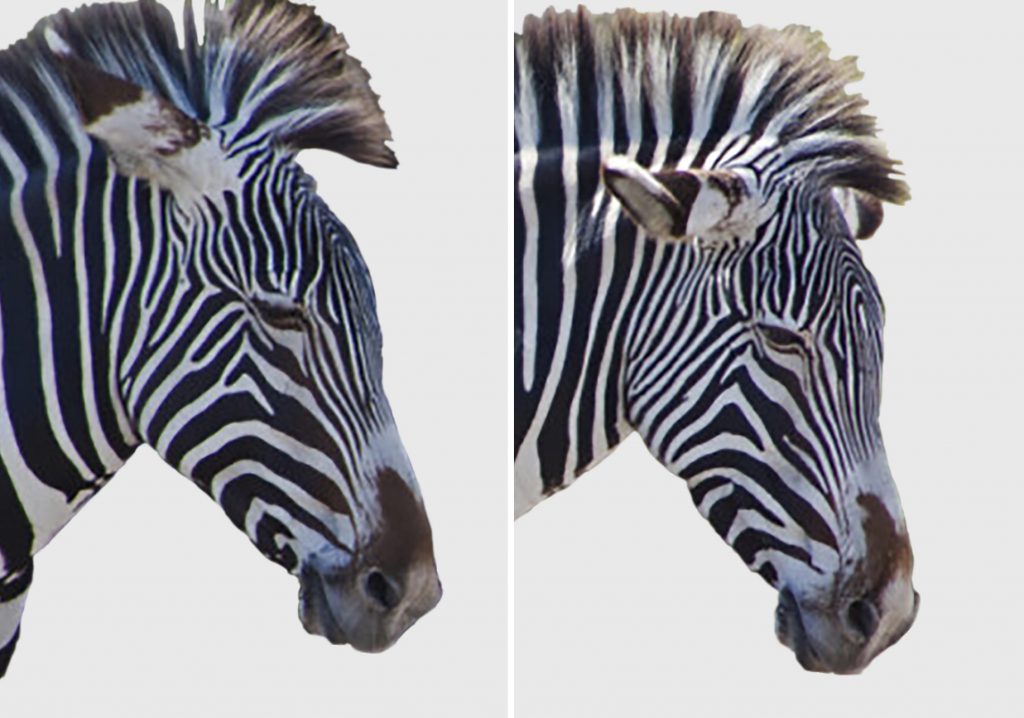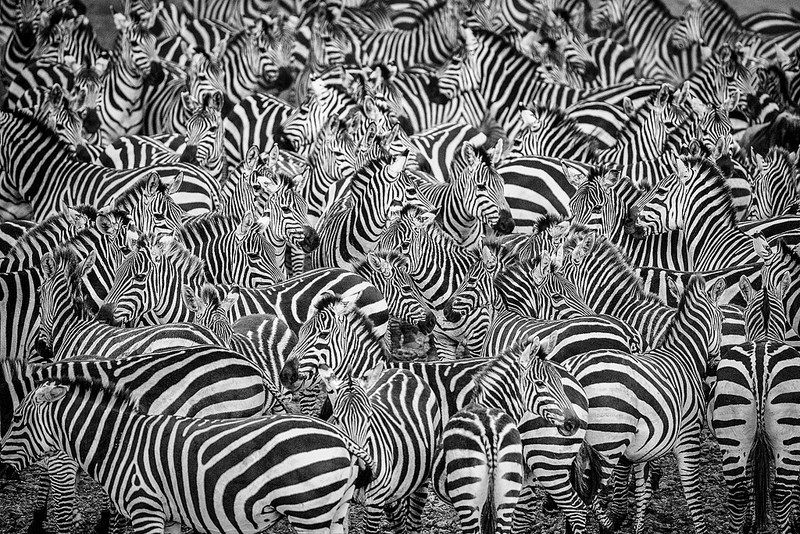How can zebras and other animals use their stripes during the migration?
One often-asked question is why do zebras have stripes? The scientific literature addressing this question raises five distinct concepts (Ruxton, 2002; Caro et al., 2014), indicating that stripes: (1) provide camouflage (Godfrey et al., 1987; Ruxton 2002); (2) disrupt predator attacks (How and Zanker, 2014); (3) balance thermal loads (Larison et al., 2015); (4) have social functions, such as group cohesion (Kingdon, 1984); and (5) aid in the avoidance of ectoparasite attack (Caro et al., 2014); however, these concepts have all been debated (Larison et al., 2015; Melin et al., 2016). At present, it is fair to conclude that we do not know the ultimate evolutionary cause (the original biological/physical pressure) that led to the evolution of stripes on zebras. While it is possible that one of the concepts outlined above is the ultimate cause, it is also just as likely that all these concepts describe useful outcomes from the presence of stripes, rather than evolutionary causes of these stripes.
Given that plains zebras are social animals, and that they do migrate in large numbers, it is possible that stripes play a useful role in the recognition of individual zebras by other co-migrating zebras. Individual recognition of each other may be very important in the navigation process, as migrating with genetically related zebras is likely to be something that younger zebras require for survival in their first few years of life, with being able to visually recognize their mother and related individuals being crucial. But how might the stripes of the zebras allow them to recognize each other?
Addressed in another part of this project is the visual acuity of the plains zebra (link). Visual acuity is a measure of the fine detail the eye of any animal can detect. Calculating this in the plains zebra is important for various reasons (link), but in the current context it can tell us to what level of detail it can recognize the pattern of stripes on other individual zebras. Humans have a visual acuity of around 60 cycles per degree, meaning that at a distance of 56 cm from our eye we can see 60 pairs of black and white lines in 1 cm width. The plains zebra is likely to have a visual acuity like the domestic horse, at less than 20 cycles per degree, meaning that they can only see 20 or less pairs of black and white lines at 56 cm from their eyes. This means it is unlikely that the plains zebras would be able to rapidly and reliably identify the precise patterns of stripes found on other zebras at any appreciable distance (indeed for humans, even with our better eyesight, have problems doing this rapidly, despite the stripe patterns varying between individuals, see pictures). Alternatively, the stripes of the plains zebras may, at low visual acuity, blur into each other and from this blurring specific patterns may emerge – and it is these emergent patterns that we propose the zebras may be making use of to visually identify individuals.

describe figure above.

Describe figure above hides image.
In the brains of several primates, a region of the temporal lobe has been found to have “face-recognition” neurons (e.g., Tsao and Livingstone, 2008). These neurons put together various characteristics of a face (or indeed other parts of the body) allowing the recognition of a specific individual. Face-recognition capacities have been reported in sheep (e.g., Kendrick et al., 2001), dogs (e.g., Cuaya et al., 2016), and domestic horses (Lansade et al., 2020), and thus the neural machinery required to recognize other individuals through vision alone are likely to be present in the plains zebra.
We propose that by investigating how emergent patterns may emerge from the stripes of the plains zebra, we will be able to reveal how the plains zebras may be able to recognize each other as individuals, both from close (e.g., from patterns emerging from the fine stripes of the face) and from a distance (e.g., from patterns emerging from the broader stripes on the flanks). It is also possible that these emergent patterns from the stripes that may signify a specific individual plains zebra may also be recognized by other migrating species, such as the blue wildebeest (link to collars with migration page).
To determine whether the stripes of the plains zebra do form an emergent pattern that could be detected by the zebras and other species, we plan to apply a range of digital transformations to the patterns of stripes on zebras and determine whether identifiable patterns that can be readily detected by the visual system of plains zebras and other species do emerge. Our preliminary observations indicate that the stripes of individual plains zebras, their thickness, and spatial frequencies, do vary across the hide (see pictures), indicating that these individual variations might lead to individually recognizable emergent patterns that could be detected by plains zebras and other migrating species.
Hypothesis: Variations in the patterns of stripes on the hides of individual plains zebra will, when appropriately transformed, lead to the emergence of individual-specific patterns that can be used by plains zebras and other migratory species to recognize individuals.
Aim and Methods: Through high-resolution photography and videography acquire images that can be analysed with a range of digital transformation algorithms to determine if the stripes of the plains zebras do produce emergent features that can be recognized biologically by zebras and other species.
Specific Objective 1: We aim to procure high-resolution photographic and videographic images of whole plains zebras (n = 10), heads only (n = 40), and complete hides (n = 40) to use for analysis. This will be undertaken on prepared (not live) specimens of adult plains zebras as these will not move, causing issues with imaging, but also allowing us to obtain the best images possible.
Specific Objective 2: These images will be analysed in several different ways. In addition to classical accomplished biometric fingerprint analysis and recognition techniques, we will use specific techniques adapted for animal stripe identification through feature detection and associated morphometrics. We will further use modern ML techniques for developing models to predict zebras with specific patterns at different sites. We will emulate ‘blur’ and other distortions ‘as could be seen’ by zebras and run different experiments based on such emergent patterns. Analysis approaches include sectorial division of the image followed by filtering to compute features (Jain et al., 1999), mathematical models defining spline curves and determining curve parameters that best fit the data (Jain and Minut, 2002), and computation of orientation field flow curves (Dass, 2004) and tangent-space isometric maps.
Sources:
Caro T, Izzo A, Reiner RC, Walker H, Stankowich T (2014) The function of zebra stripes. Nature Comm 5:3535.
Cuaya LV, Hernandez-Perez R, Concha L (2016) Our faces in the dog’s brain: function imaging reveals temporal cortex activation during perception of human faces. PLoS One 11:e0149431
Dass SC (2004) Markov random field models for directional field and singularity extraction in fingerprint images. IEEE Trans Image Processing 13:1358-1367.
Godfrey D, Lythgoe JN, Rumball DA (1987) Zebra stripes and tiger stripes: the spatial frequency distribution of the pattern compared to that of background is significant in display and crypsis. Biol J Linnean Soc 32:427-433.
How MJ, Zanker JM (2014) Motion camouflage induced by zebra stripes. Zoology 117:163-170.
Jain AK, Minut S (2002) Hierarchical kernel fitting for fingerprint classification and alignment. Proc 16th Int Conference on Pattern Recognition 2:469-473.
Jain AK, Prabhakar S, Hong L (1999) A multichannel approach to fingerprint classification. IEEE Trans Pattern Anal Mach Intell 21:348-359.
Kendrick KM, da Costa AP, Leigh AE, Hinton MR, Peirce JW (2001) Sheep don’t forget a face. Nature 414:165-166.
Kingdon J (1984) The zebra’s stripes: an aid to group cohesion. In: They Encyclopedia of Mammals (D. MacDonald, ed.) pp. 486-487. Equinox, Oxford, UK.
Lansade L, Colson V, Parais C, Reigner F, Bertin A, Calandreau L (2020) Human face recognition in horses: data in favor of a holistic process. Front Psychol 11:575808
Larison B, Harrigan RJ, Thomassen HA, Rubenstein DI, Chan-Golston AM, Li E, Smith TB (2015) How the zebra got its stripes: a problem with too many solutions. R Soc Open Sci 2:140452
Melin AD, Kline DW, Hiramatsu C, Caro T (2016) Zebra stripes through the eyes of their predators, zebras, and humans. PLoS One 11:e0145679
Ruxton GD (2002) The possible fitness benefits of striped coat coloration for zebra. Mamm Rev 32:237-244.
Tsao DY, Livingstone MS (2008) Mechanisms of face perception. Annu Rev Neurosci 31:411-437.

Where’s Wally?
